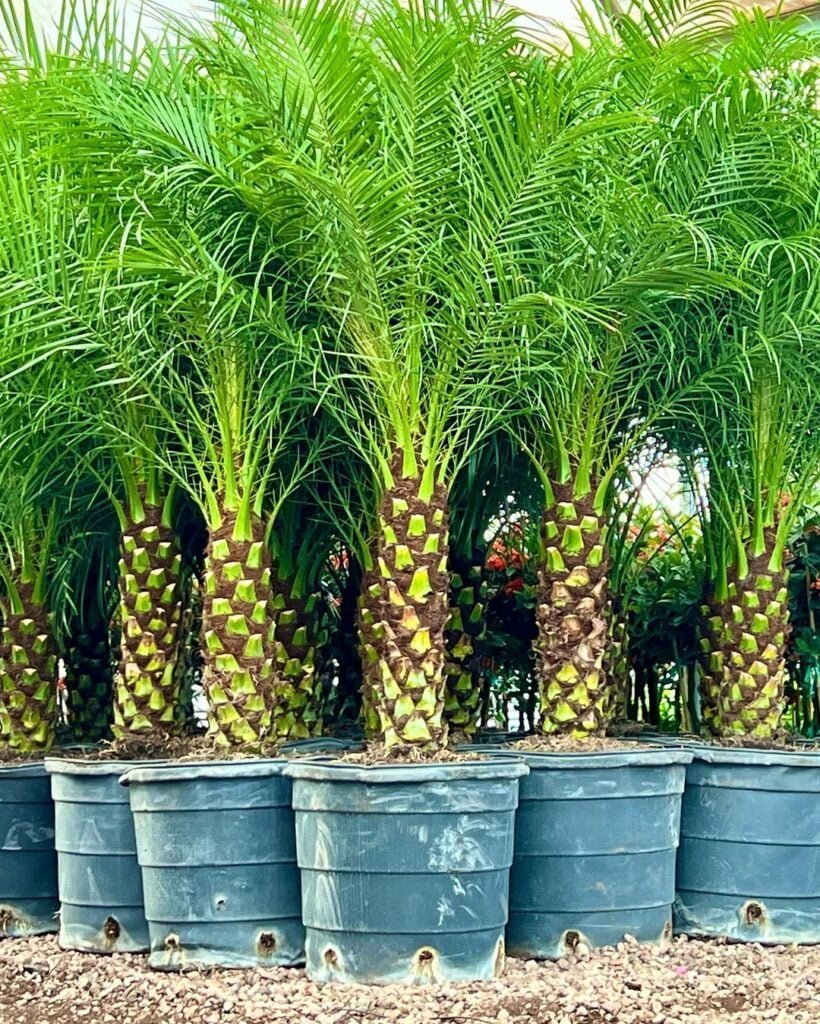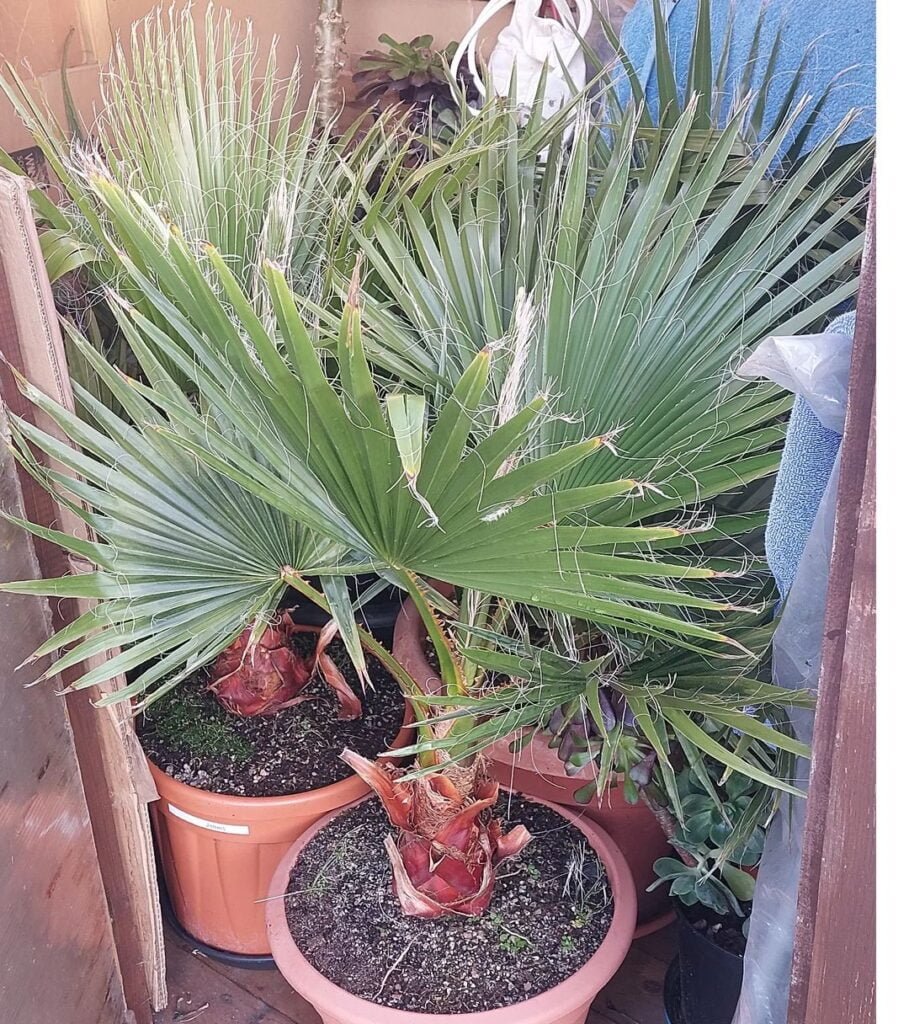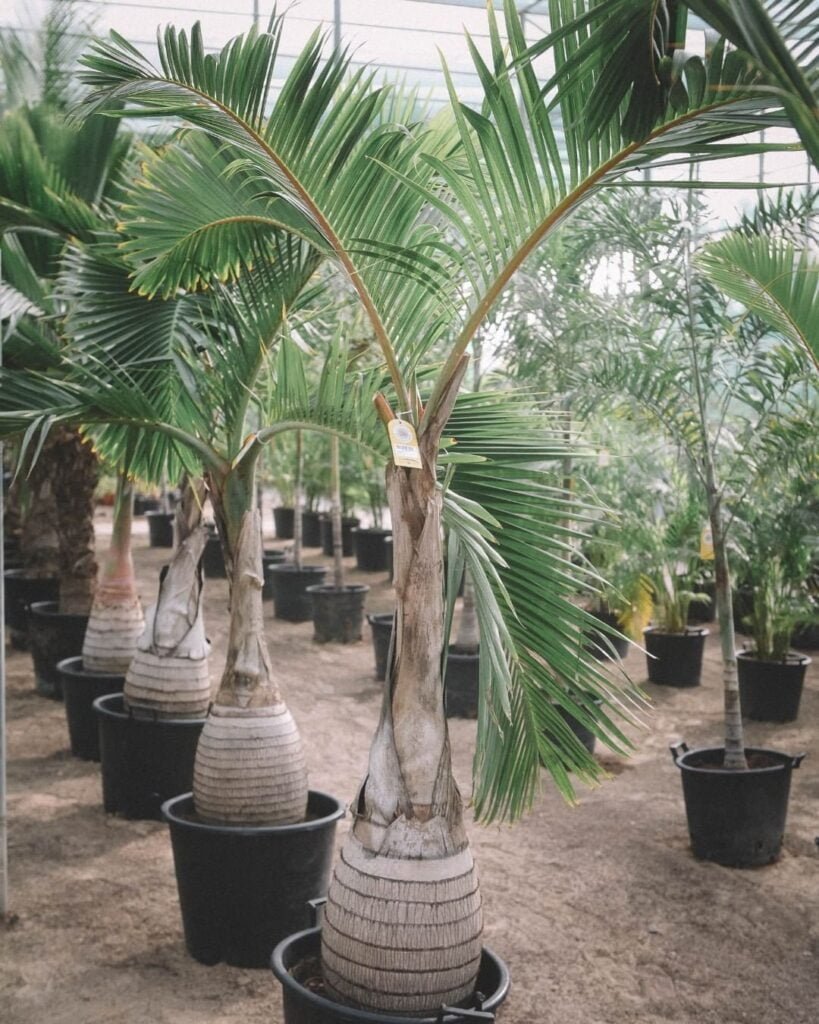Having potted palm trees outdoors can really elevate your yard, patio or deck area. Palm trees add a tropical, resort-like feel and make any outdoor space more inviting. But with so many varieties to choose from, it can be tricky deciding which potted palms work best outside.
This guide will cover the most popular and hardy palm trees perfect for growing in pots or planters outdoors. You’ll find descriptions and pictures to help identify them, plus tips on sizing and caring for potted outdoor palms.
Lady Palm (Rhapis excelsa)

Here’s a short information chart for the Lady Palm tree:
| Attribute | Information |
|---|---|
| Botanical Name | Rhapis excelsa |
| Plant Type | Evergreen palm |
| Soil Type | Well-drained, rich, loamy soil |
| Color Varieties | Green foliage |
| Zones | 9-11 (USDA Hardiness Zones) |
| Exposure | Bright, indirect light to partial shade |
| Bloom Time | Rarely flowers indoors |
| Height/Spread | 6-12 feet tall / 2-4 feet wide |
Rhapis excelsa, also known as broadleaf lady palm or bamboo palm . The Lady Palm is a excellent multi-trunk palm well-suited to pot life. It has an exotic, feathery appearance with cascading fronds and can grow 4-10 feet tall.
Lady Palms do best in bright, indirect light and moist, well-draining soil. Let the surface dry between waterings. They make great accents near doors, on patios or lining walkways.
Sago Palm (Cycas revoluta)

Here’s a short information chart for the Sago Palm:
| Attribute | Information |
|---|---|
| Botanical Name | Cycas revoluta |
| Plant Type | Evergreen cycad (not a true palm) |
| Soil Type | Well-drained, sandy or loamy soil |
| Color Varieties | Green foliage |
| Zones | 9-11 (USDA Hardiness Zones) |
| Exposure | Full sun to partial shade |
| Bloom Time | Non-flowering (produces cones) |
| Height/Spread | 3-10 feet tall / 3-10 feet wide |
Don’t let the name fool you – the Sago Palm is actually a cycad, not a true palm. But it still has that classic palm tree look with a thick, shaggy trunk and stiff, feather-like fronds radiating outward in an umbrella pattern.
Sago Palms are very low-maintenance once established. They tolerate heat and drought well. Just avoid overwatering and give them plenty of sun. These slow growers work nicely as focal points in larger pots or planters on decks or patios.
Pygmy Date Palm (Phoenix roebelenii)

Here’s a short information chart for the Pygmy Date Palm:
| Attribute | Information |
|---|---|
| Botanical Name | Phoenix roebelenii |
| Plant Type | Evergreen palm |
| Soil Type | Well-drained, loamy or sandy soil |
| Color Varieties | Green foliage |
| Zones | 10-11 (USDA Hardiness Zones) |
| Exposure | Full sun to partial shade |
| Bloom Time | Spring to summer |
| Height/Spread | 6-12 feet tall / 6-10 feet wide |
As the name suggests, the Pygmy Date Palm is a smaller, more compact variety reaching only 6-10 feet tall at maturity. It has an upright, single trunk with long, arching fronds in a beautiful diamond pattern.
Pygmy Dates are extremely cold hardy compared to most palms. They can be planted outdoors year-round in warm climates or enjoyed seasonally in colder areas by moving the pots inside during winter.
Mediterranean Fan Palm (Chamaerops humilis)

Here’s a short information chart for the Mediterranean Fan Palm:
| Attribute | Information |
|---|---|
| Botanical Name | Chamaerops humilis |
| Plant Type | Evergreen palm |
| Soil Type | Well-drained, sandy or loamy soil |
| Color Varieties | Green foliage |
| Zones | 8-11 (USDA Hardiness Zones) |
| Exposure | Full sun to partial shade |
| Bloom Time | Spring |
| Height/Spread | 6-15 feet tall / 6-15 feet wide |
The Mediterranean Fan Palm is tough as nails with its rugged trunk covered in rough fiber and dense, semi-circular fan leaves. It can withstand freezing temps, wind, drought and neglect.
Fan Palms have a maximum size of around 10-15 feet, making them a nice fit for larger containers on decks, patios or flanking entries. They need excellent drainage and do best with occasional deep waterings versus frequent light waterings.
Christmas Palm (Adonidia merrillii)

Here’s a short information chart for the Christmas Palm:
| Attribute | Information |
|---|---|
| Botanical Name | Adonidia merrillii |
| Plant Type | Evergreen palm |
| Soil Type | Well-drained, sandy or loamy soil |
| Color Varieties | Green foliage |
| Zones | 10-12 (USDA Hardiness Zones) |
| Exposure | Full sun to partial shade |
| Bloom Time | Year-round |
| Height/Spread | 15-25 feet tall / 5-10 feet wide |
For a pop of festive red color, you can’t beat the Christmas Palm. Its smooth, slender trunks are crowned with lengths of long, feathery fronds in a deep crimson hue that resemble ribbons.
As a tropical plant, the Christmas Palm prefers heat, humidity, and plenty of bright light. Grow it in a well-draining potting mix and water when the top inch of soil is dry. It makes an eye-catching centerpiece in a bright patio container.
Chinese Fan Palm (Livistona chinensis)

Here’s a short information chart for the Chinese Fan Palm:
| Attribute | Information |
|---|---|
| Botanical Name | Livistona chinensis |
| Plant Type | Evergreen palm |
| Soil Type | Well-drained, sandy or loamy soil |
| Color Varieties | Green foliage |
| Zones | 9-11 (USDA Hardiness Zones) |
| Exposure | Full sun to partial shade |
| Bloom Time | Spring to summer |
| Height/Spread | 20-50 feet tall / 10-15 feet wide |
Another excellent fan palm is the Chinese Fan. It has large, nearly circular fan leaves on a solitary trunk that develops a distinctive diamond pattern as it ages.
Chinese Fans are slower growing than many other palms, but very tolerant of drought, cold, wind and poor soil once mature. Their petite 6-10 foot size is ideal for containers and smaller spaces like courtyard gardens.
Mexican Fan Palm (Washingtonia robusta)

Here’s a short information chart for the Mexican Fan Palm:
| Attribute | Information |
|---|---|
| Botanical Name | Washingtonia robusta |
| Plant Type | Evergreen palm |
| Soil Type | Well-drained, sandy or loamy soil |
| Color Varieties | Green foliage |
| Zones | 9-11 (USDA Hardiness Zones) |
| Exposure | Full sun |
| Bloom Time | Summer |
| Height/Spread | 70-100 feet tall / 10-15 feet wide |
For tall drama, look no further than the Mexican Fan Palm. It can soar over 100 feet high in the ground, but fortunately tops out at a more modest 10-15 feet when grown in a container.
Mexican Fans boast massive, 6-foot wide circular fan leaves at their crown which create dense shade below. Plant one in a large deck or patio pot as a show-stopping focal point that provides ample cooling coverage.
Bottle Palm (Hyophorbe lagenicaulis)

Here’s a short information chart for the Bottle Palm:
| Attribute | Information |
|---|---|
| Botanical Name | Hyophorbe lagenicaulis |
| Plant Type | Evergreen palm |
| Soil Type | Well-drained, sandy or loamy soil |
| Color Varieties | Green foliage |
| Zones | 10-11 (USDA Hardiness Zones) |
| Exposure | Full sun to partial shade |
| Bloom Time | Summer |
| Height/Spread | 10-12 feet tall / 5-7 feet wide |
The unique Bottle Palm has a bulbous, bottle-shaped trunk that stores water to help it survive drought. This gives it an eccentric, sculptural appearance unlike any other palm.
Bottle Palms have a moderate growth rate of about 12-24 inches per year until reaching their full 15-20 foot height outdoors. In a pot they stay much smaller – around 6 feet max. Give them bright light and well-draining soil.
Majesty Palm (Ravenea rivularis)

Here’s a short information chart for the Majesty Palm:
| Attribute | Information |
|---|---|
| Botanical Name | Ravenea rivularis |
| Plant Type | Evergreen palm |
| Soil Type | Well-drained, sandy or loamy soil |
| Color Varieties | Green foliage |
| Zones | 9-11 (USDA Hardiness Zones) |
| Exposure | Bright, indirect light to partial shade |
| Bloom Time | Rarely flowers indoors |
| Height/Spread | 10-20 feet tall / 5-10 feet wide |
For year-round tropical vibes, you need a Majesty Palm. This upright palm has a dense, feathery crown of arching fronds atop a slender trunk wrapped in green criss-crossing patterns.
Majesty Palms perform best outside in warm, humid areas. In cooler climates, they can be grown in containers and moved indoors for winter. Provide plenty of sun, heat, moisture and nutrients for maximum growth and frond production.
Those are some top choices for potting palms outdoors! Be sure to pick a spot with adequate sun, use a quality potting mix, and don’t overwater. With their lush foliage and sculptural shapes, outdoor potted palms instantly boost any yard or patio’s resort flair.
Pingback: The Best Potted Palm Trees For Outdoors (With P...
Pingback: All About Crepe Myrtles: Beautiful Southern Flowering Trees -
Pingback: How to Grow and Care for Areca Palms - Gardener's School
Pingback: How to Grow and Care for Alocasia Frydek -
Pingback: The Best Potted Palm Trees For Outdoors (With P...
Pingback: Circle Garden Design: Crafting Elegance in Your Outdoor
Pingback: How to Propagate Rosemary: Turn One Plant Into Dozens
Pingback: How to Grow Lots of Ginger in Containers -
Pingback: 10 Amazing Uses and Benefits of Kentia Palms
Pingback: A Guide to Growing & Caring for Verbena: Endless Color from Spring to Fall -
Pingback: Complete Guide to Growing Dragon Fruit Plants at Home -
Pingback: Sago Palm Plants : How to Easily Grow and Care
Pingback: How to Grow and Care for Staghorn Fern: A Complete Guide for Breathtaking Greenery
Pingback: Beauty Bark vs. Living Ground Cover: Which is Best for Your Garden?
Pingback: Amazing Nature’s Trees that start with P
Pingback: Prickly Pear Cactus (Opuntia) : Comprehensive Guide to Caring
Pingback: How to Get Rid of Thrips Effectively : A Comprehensive Guide
Pingback: The Best Office Plants for Happy Workers: Bringing Nature Indoors